1950s
Warming Pills
Glycine is readily available as a supplement. I hadn't heard about its supposed warming properties.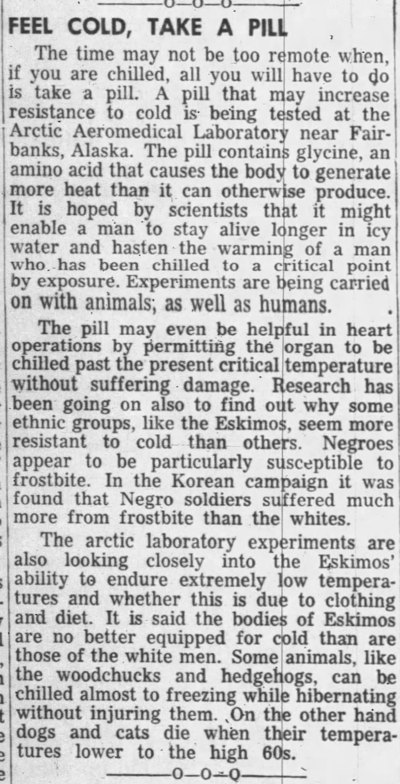
Scranton Times-Tribune - July 25, 1957
I searched for the research that inspired the newspaper report above and found a 1956 study, conducted at the Arctic Aeromedical Laboratory, that involved immersing dogs in freezing water. The researchers measured how long it took for the rectal temperature of the dogs to lower to 26°C. Dogs that had been given glycine took longer to chill (and warmed up more rapidly) than the control group:
The intravenous administration of a 5% glycine solution caused a significant increase of 34.6 minutes in the time required to lower the rectal temperature of dogs from 38°C to 26°C. Total rewarming time was decreased by 34.3 minutes in the glycine treated group. The differences in cooling and rewarming rates between the treated and non-treated animals was due to the increased heat production observed in the dogs receiving glycine. The possible applicability of thermogenic agents in accidental hypothermia is discussed.
However, I then found a 1961 study, also from the Arctic Aeromedical Laboratory (but this time conducted on humans) that seemed to cast doubt on the warming properties of glycine:
I think I'll stick with whiskey for warmth.
Posted By: Alex - Tue Aug 15, 2023 -
Comments (3)
Category: Experiments, 1950s
Copacabana Chorus Introduces Alcoa Alumalure

Posted By: Alex - Sun Aug 13, 2023 -
Comments (1)
Category: Architecture, Advertising, 1950s
Miss Automatic Gas Range
You can find Irmgard Dawson's IMDB page here.You can also find some biographical info about her in the text of a 1965 court case, Levitt v. Levitt, in which her former husband, Gene Levitt, was suing to lower his alimony payments to her. The document says that in the late 1950s Dawson had moved back to Germany where her sole source of income was the alimony. Nevertheless, the court agreed to lower the payments to a "token amount."
Gene Levitt was a TV writer best known for creating the Fantasy Island series.
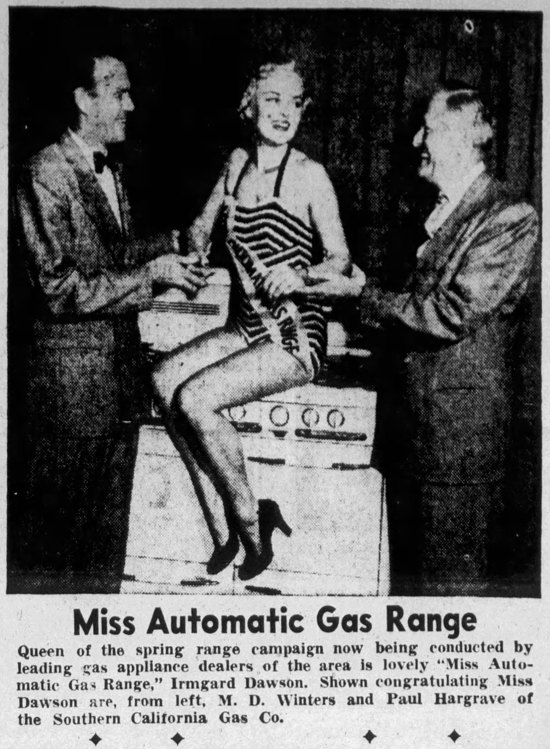
Highland Park News-Herald - Apr 24, 1953
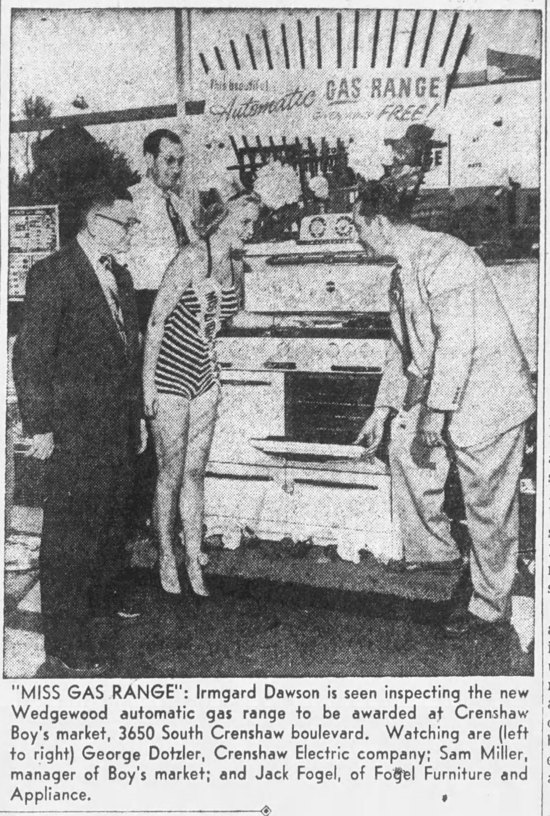
Los Angeles Southwest Wave - May 10, 1953
In 1944, Dawson had also won the title of "Watermelon-Eating Queen of Florida" at a contest in Miami Beach. Note that her crown was carved from a watermelon.
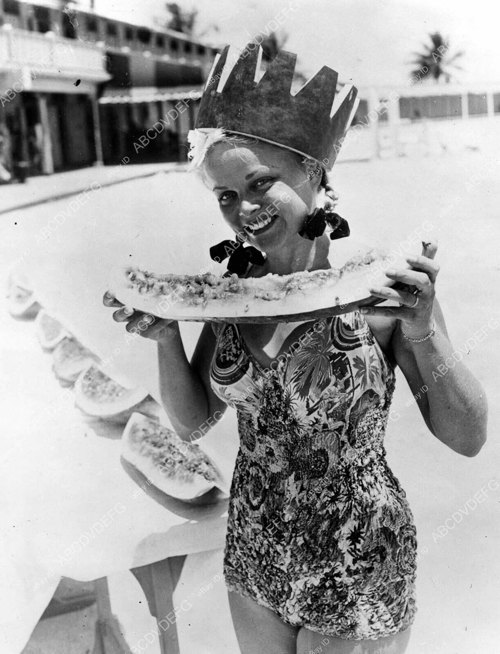
Posted By: Alex - Thu Aug 10, 2023 -
Comments (0)
Category: Awards, Prizes, Competitions and Contests, 1950s
The Edsel Show
Even titanic star power could not save this famous automobile disaster. The interspersed commercials are great too.
Posted By: Paul - Tue Aug 01, 2023 -
Comments (0)
Category: Success & Failure, Television, Disgrace, Shame, Infamy and Downfalls, Advertising, 1950s, Cars
Miss Radioactive
In 1955, two women (Jeanne Baird and Sandy Hershey) were separately named "Miss Radioactive." I can't find any evidence of this title being used before or after 1955.They both seem to be displaying the same type of radiation detector — a scintillometer. If, like me, you weren't aware of the difference between a Geiger counter and a scintillometer, you can read about it here.
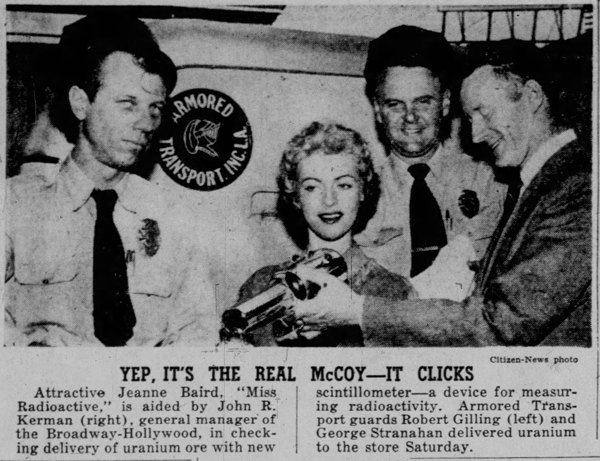
Los Angeles Evening Citizen News - Feb 14, 1955
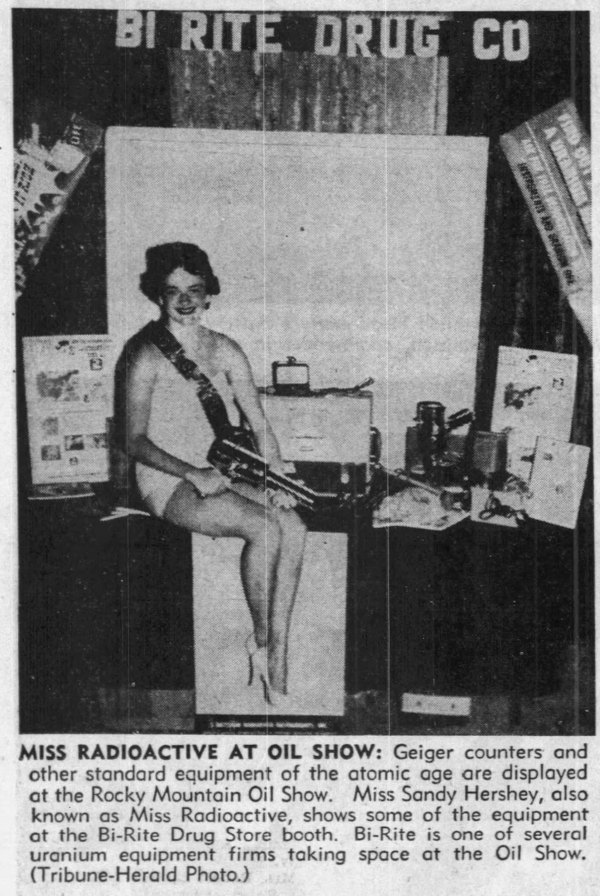
Casper Star Tribune - June 24, 1955
Posted By: Alex - Fri Jul 28, 2023 -
Comments (2)
Category: Awards, Prizes, Competitions and Contests, Atomic Power and Other Nuclear Matters, 1950s
Result of artificial sleep in a biological experiment
In the 1950s, reports came out of the Soviet Union about an unusual experiment in which a dog's life was radically lengthened by putting it into an artificial sleep for three months.The research was done by S.N. Braines (I have no idea what "S.N." stands for). I believe that he reported his results in a 1952 article titled, "Result of artificial sleep in a biological experiment," published in a Soviet journal. But I can't be sure because I can't find the text of the article.
The results he achieved sound unlikely to me.

Omaha World-Herald - Oct 17, 1958

Text from Main Street, U.S.S.R. (1959), by Irving R. Levine
Posted By: Alex - Wed Jul 26, 2023 -
Comments (3)
Category: Sleep and Dreams, Experiments, Dogs, 1950s, Longevity
How television benefits your children
The text of the ad basically admits that it's the parents that television benefits, not the children. Because TV is the greatest nanny ever created. Park the kids in front of the boob tube and you don't have to worry about keeping them out of trouble.

Advertising Age - Sep 11, 1950
Posted By: Alex - Tue Jul 25, 2023 -
Comments (1)
Category: Television, Advertising, Children, 1950s
Miss Crustacean
In 1951, Meta Justice became the first "Miss Crustacean." She was awarded the title at the annual crab derby in Crisfield, Maryland. She died last year (2022), and her obituary mentions the title. So it must have been something she was proud of.
Salisbury Daily Times - Aug 27, 1951

Baltimore Sun - Aug 27, 1951
In 1952, the festival committee decided to change the title from "Miss Crustacean" to "Miss Hard Crab Derby." They explained that Miss Crustacean "turned out to be altogether too cryptic, with people in general not understanding what it meant."
However, in subsequent years the title reverted to being "Miss Crustacean." Evidently that was less cryptic than "Miss Hard Crab Derby."

Baltimore Evening Sun - Sep 1, 1953
The annual tradition of bestowing the title of "Miss Crustacean" on a young woman continues to this day in Crisfield. Check out the highlights of the 2019 competition below.
More info: National Hard Crab Derby
Posted By: Alex - Fri Jul 21, 2023 -
Comments (3)
Category: Awards, Prizes, Competitions and Contests, Oceans and Maritime Pursuits, 1950s
Always on Call
Posted By: Paul - Sat Jul 15, 2023 -
Comments (0)
Category: Police and Other Law Enforcement, PSA’s, Social Services, 1950s
What will the telephone be like when I grow up?
Perhaps some day in the future you may just speak the number into the transmitter and get your party automatically.
The introduction of universal direct dialing was a pretty safe guess in 1953, since direct dialing had, by then, already been introduced in some places.
It's more impressive that the ad writers also successfully predicted the introduction of voice recognition technology.

Life - May 18, 1953
Posted By: Alex - Tue Jul 11, 2023 -
Comments (1)
Category: Technology, Telephones, 1950s, Yesterday’s Tomorrows

| Who We Are |
|---|
| Alex Boese Alex is the creator and curator of the Museum of Hoaxes. He's also the author of various weird, non-fiction, science-themed books such as Elephants on Acid and Psychedelic Apes. Paul Di Filippo Paul has been paid to put weird ideas into fictional form for over thirty years, in his career as a noted science fiction writer. He has recently begun blogging on many curious topics with three fellow writers at The Inferior 4+1. Contact Us |




